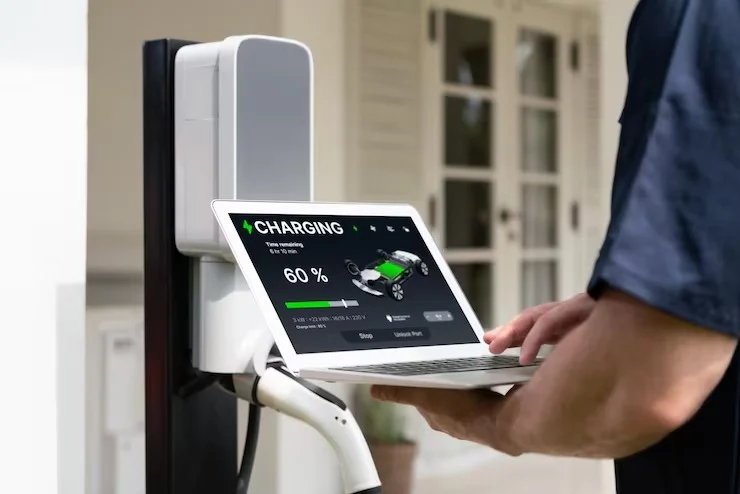As electric vehicles (EVs) become more and more ordinary in residential and commercial spaces, one of the major factors for preparing an installation for EV adoption is electrical planning. At its very core, the plan consists of load calculation for the installation of EV chargers.
Load calculation for EV chargers are essential for safety, the correct application of electrical codes, and the proper performance of your charging system. So, as a homeowner, you would be interested in knowing the load calculation for the personal charging station. And if you are a business, multiple charging units would engage you in load calculation.
In this guide, we shall analyze how to perform load calculation, understand the difference in residential EV charger load calculation versus commercial EV charger load calculation, and break down the requirements for Level 1, Level 2, and DC fast chargers.

Working On Load Calculation for EV Chargers
Electrical load calculation is a process of specifying the total power demand of a given circuit or panel of electrical service. On EV chargers, this becomes more important because:
- Privacy High Demand: EV chargers draw ample amounts of current, and sometimes this current can be compared to that of a large appliance, like HVAC systems or electric ovens for heating.
- Safety: Failing to perform proper load calculations may cause overloading of a circuit, developing a shortage, overheating, and becoming a potential fire hazard.
- Conforming to the Law: Codes such as those of the National Electrical Code in the U.S., or those that exist worldwide, stipulate proper load calculation before installation.
- Prepared for the Future: Thus, while performing load calculations, nearly everything is integrated, and the charging infrastructure in place will suffice for present as well as future EV charging needs without requiring an overhaul.
A proper load calculation would help avoid tripped breakers on charging, inefficient charging, and even loss of electrical functions due to safety failure.
Load Calculation for EV Charger Installations
Before considering specifics for a particular charger, here is a general step-wise approach to how a load calculation is done:
Step 1: Identify Charger Type and Rating
- Level 1 chargers: 120 volts, usually 12–16 amps
- Level 2 chargers: 240 volts, usually 30–50 amps
- DC fast chargers: 400V–800V, from 50 kW to 350 kW of power, require much more current
Step 2: Circuit Requirements
Check the manufacturer’s specifications. For example:
- A 40A charger requires a 50A circuit breaker (80 percent rule).
- NEC requires that the continuous load (like EV charging) shall not exceed 80 percent of the rating of a circuit breaker.
Step 3: Check Electrical Panel Capacity
- Check your panel’s main breaker rating (usually 100A, 150A, 200A for homes, much higher for commercial).
- Add existing loads (HVAC, lighting, appliances).
- Check if there is sufficient capacity now for EV charging.
Step 4: Consider Demand Factors
Electrical codes allow demand factors (load diversity assumptions) to be accounted for to prevent the overestimation of loads, especially for commercial EV charger load calculation, where multiple chargers may not be working at full capacity simultaneously.
Step 5: Finalize Load Calculation
- Check if your current panel can take the additional charger load.
- If not, an upgrade to the panel, sub-panel installation, or load management system needs to be planned.
Residential EV Charger Load Calculation
For the homeowner, the objectives are to somehow add an EV charger to the service without overloading it.
Example of load calculations for a home: Level 2 EV Charger
- Charger rating: 40A continuous.
- Required breaker: 50A.
- Additional load = 9.6 kW (240V x 40A).
- Home panel: 200A service, already at around 120A in use for appliances and HVAC.
Calculation:
200A – 120A = 80A left.
Add a 40A load for the charger.
The panel is thus able to take this charger without upgrades.
In different instances, a residential EV charger load calculation will shoulder the burden of suggesting an upgrade for the panel or using smart load sharing devices that give priority to charging whenever demand is low.

Commercial EV Charger Load Calculation
Commercial installations are more complex because running several chargers in parking lots, depots, or workplace settings is considered.
Considerations for Commercial Load Calculation:
- Number of Chargers: Each charger is considerably demanding.
- Diversity Factor: All chargers will not be used at the same time.
- Load Management Systems: Smart charging can vary the power distribution to avoid overloads.
- Utility Coordination: Very high loads would require coordination between utility companies to upgrade transformers.
Example: Commercial Setup with 10 Level 2 Chargers
- Each charger: 40A continuous load.
- Total connected load: 400A.
- Applying diversity factor: Assume only 70% simultaneous use = 280A.
- Building service: 600A capacity.
In this scenario, the system can handle the chargers with careful planning, though a dedicated sub-panel might be recommended.
Load Calculation for Level 1 EV Charger
Being the lowest level chargers, they are usually not designated for heavy calculations.
- Voltage – 120 volts
- Current – 12 to 16 amps
- Power – 1.4 to 1.9 kW
Example Load Calculation Level 1 EV Charger
120V x 12A = 1.44 kW extra load
Practically, this is as commonplace as drawing for a small microwave or toaster on a 15A or 20A outlet. Such installations do not stress ordinary outlets.
Load Calculation for Level 2 EV Charger
Level 2 chargers are mostly the choice for residential and light commercial settings. They deliver much faster charging while also offering higher conditions.
- Voltage: 240V
- Current: Generally, 30–50A (can exceed this)
- Power: 7.2-12 kW
Load Calculation Example
240V x 40A = 9.6 kW continuous load
Breaker required: 50A (by the 80% rule)
For many homes with 100A service, installing a Level 2 charger may require panel upgrades. Load balancing solutions also apply in commercial cases; wherein multiple Level 2 chargers are in use.
Load Calculation for DC Fast Charger
Due to their high-power requirements, DC fast chargers (DCFCs) are mostly installed at commercial or public charging stations.
Voltage: 400-800V
Current: Hundreds of amperes.
Power rating: I50kW-350kW
Load Calculation Example
On a 400-volt supply, 150 kW requires 375 amps (150,000 W ÷ 400V).
Multiple DC fast chargers often require utility-scale infrastructure upgrades for electrical service, such as dedicated transformers or medium-voltage connections.
Smart Solutions with Load Management
Due to the demand these charge points can create, being installed with one or more smart load management strategies is now becoming a trend:
- Dynamic Load Balancing: Provides the available power to different chargers.
- Time Window Charging: Charges during utility off-peak hours.
- Energy Storage Integration: Uses battery cells to counter the demand from the grid.
- Solar Integration: Comes with a renewable power source alongside EV charging for sustainability.
Such solutions help reduce panel-related and utility connection-related stresses, especially on the EV Charging Load.
Key Regulatory Considerations
When doing the load calculation, make sure to consider codes or standards applicable to the location:
- NEC (U.S.): Articles 210, 220, and 625 for the installation of an EV charger
- IEC Standard (Europe): IEC 61851 for charging systems for EV
- Local Utility Ruling: Numerous utilities have the latest requirements to inform or obtain approval before setting high-power chargers for their consumer.
Ignoring can mean an insult to the authority, with failed inspections, halt orders, and fines to follow. Plus, installation might turn unsafe.
Common Errors in EV Charger Load Calculation
- Ignoring Continuous Load Rule: Forgetting the 80% rule for breakers and getting circuits undersized.
- Either Overestimating or Underestimating Demand: Mistakes in the application of diversity factors will lead to either wording planning distortions or incorrect planning
- Neglecting Panel Limitation: Adding chargers without seeking the preparation of the panel size will put the panel at risk of overloading.
- Overlooking Any Future Needs: Planning for one EV only will be cumbersome once multiple chargers are needed soon.
Avoiding these errors will guarantee safe, scalable, and cost-effective installations.
Future of Load Calculations: What to Look for in 2030
If EV adoption and sales continue at the steady pace they have been, load calculations will certainly evolve with time and technology:
- Solid-State Batteries: They might reduce charging time, but on the other hand, they’d increase peak loads.
- Bidirectional Charging (V2G): Demand profiles may change with cars feeding energy back into the grid.
- Intelligent Load Management Using AI: Intelligent load profiles will be predicted by the system in order to allocate energy.
- Ultra-Fast Charging: With regard to 350 kW+ chargers, the more robust load calculations shall be necessary.
Conclusion
Put simply, load calculations for EV charger installation lay the foundation upon which one can design a man-made safe and efficient infrastructure for EV charging. Whether it is a very simple residential EV charger load calculation to supply a single-car garage or a complex commercial EV charger load calculation to accommodate a fleet depot, the whole procedure will help guarantee the electrical systems are capable enough in handling the demand reliably.
By being aware of how to perform a load calculation and applying it properly to Level 1, Level 2, and DC fast chargers, both homeowners and the commercial sector shall be able to plan installations that suffice present requirements while being looked upon in preparation for tomorrow’s growth.
With EV adoption continuing to grow, load calculation will be more than just a technical necessity-the real key to the furtherance of a sustainable, electric-based life.


